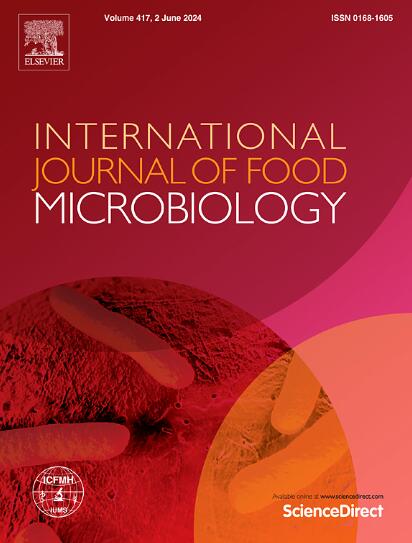揭示单核细胞增生李斯特菌在冷冻马铃薯加工中的持久性:来自全基因组测序分析的见解
IF 5
1区 农林科学
Q1 FOOD SCIENCE & TECHNOLOGY
International journal of food microbiology
Pub Date : 2025-06-30
DOI:10.1016/j.ijfoodmicro.2025.111334
引用次数: 0
摘要
单核细胞增生李斯特菌的持久性仍然是食品工业的一个问题,包括冷冻蔬菜/土豆加工业。这项研究证明了全基因组测序(WGS)对食品企业内持久性和传播途径的附加价值。从环境样本(包括员工的鞋子)中收集了79个分离株,收集时间为三年(2020 - 2022年),以及两个中间产品样本和一个最终产品样本,并提交给WGS。分离菌株是在马铃薯加工厂冷冻隧道内及周围经过焯水和油炸后提取的。82株分离株中,56株为单核增生乳杆菌,17株为innocul, 2株为粪肠球菌,7株为TYGS (Type Strain Genome Server)和FastANI (Fast Average Nucleotide Identity)检测结果不明确或混合。使用99.5%的ANI值截断来识别聚类。在cgMLST结果的两两比较中,单个大的单核增生乳杆菌簇包含56个已确认的分离株中的55个,并且显示出少于6个等位基因差异。两个群中分别有12株和5株菌株。结果表明单核增生乳杆菌至少持续存在三年,并确定员工的鞋子和工具车的车轮是潜在的传播载体。中间产物样品的分离株属于单核增生乳杆菌群,表明经冷冻隧道污染后的产物。然而,最终产品分离物不属于单核增生乳杆菌群集,提示该设施内存在其他高风险区域。在单核增生乳杆菌和innocua乳杆菌集群以及单核增生乳杆菌最终产物分离物中鉴定了与毒力、应激反应、生物膜形成和消毒剂抗性相关的各种基因。本文章由计算机程序翻译,如有差异,请以英文原文为准。
Unravelling Listeria monocytogenes persistence in frozen potato processing: Insights from whole genome sequencing analysis
Listeria monocytogenes persistence remains an issue in the food industry, including the frozen vegetable/potato processing industry. This study demonstrates the added value of whole genome sequencing (WGS) for persistence and transmission routes within food businesses. A total of 79 isolates from environmental samples (including employees' shoes), collected over three years (2020−2022), along with two intermediate product samples, and one end product sample, and submitted for WGS. The isolates were taken from in and around the freezing tunnel of a potato processing plant after blanching and frying. Of the 82 isolates, 56 were confirmed as L. monocytogenes, 17 as L. innocua, two as Enterococcus faecalis, and seven had unclear/mixed results using both TYGS (Type Strain Genome Server) and FastANI (Fast Average Nucleotide Identity). Clusters were identified using a 99.5 % ANI value cutoff. A single large L. monocytogenes cluster encompassed 55 of the 56 confirmed isolates and exhibited fewer than six allelic differences in pairwise comparisons based on cgMLST results. Two L. innocua clusters comprised 12 and five isolates, respectively. The results indicated L. monocytogenes persistence for at least three years and identified employees' shoes and a tool cart's wheels as potential transmission vehicles. The isolates of intermediate product samples belonged to the L. monocytogenes cluster, indicating post-contamination via the freezing tunnel. However, the end product isolate did not belong to the L. monocytogenes cluster, suggesting other high-risk areas within the facility. Various genes related to virulence, stress response, biofilm formation, and disinfectant resistance were identified in both L. monocytogenes and L. innocua clusters and in the L. monocytogenes end product isolate.
求助全文
通过发布文献求助,成功后即可免费获取论文全文。
去求助
来源期刊
CiteScore
10.40
自引率
5.60%
发文量
322
审稿时长
65 days
期刊介绍:
The International Journal of Food Microbiology publishes papers dealing with all aspects of food microbiology. Articles must present information that is novel, has high impact and interest, and is of high scientific quality. They should provide scientific or technological advancement in the specific field of interest of the journal and enhance its strong international reputation. Preliminary or confirmatory results as well as contributions not strictly related to food microbiology will not be considered for publication.

 求助内容:
求助内容: 应助结果提醒方式:
应助结果提醒方式:


